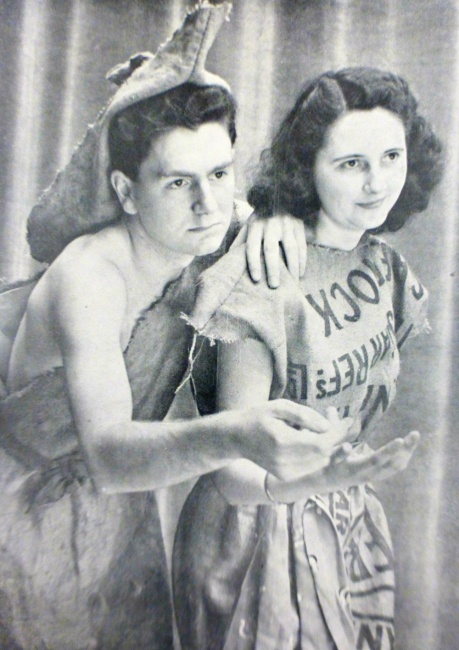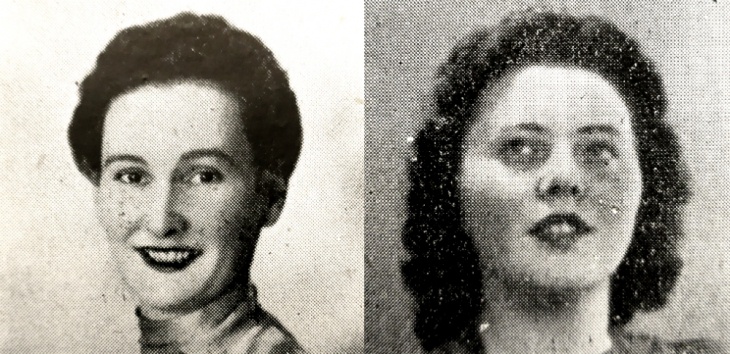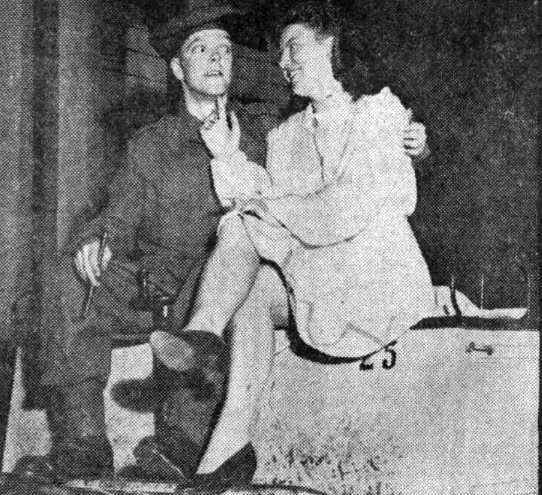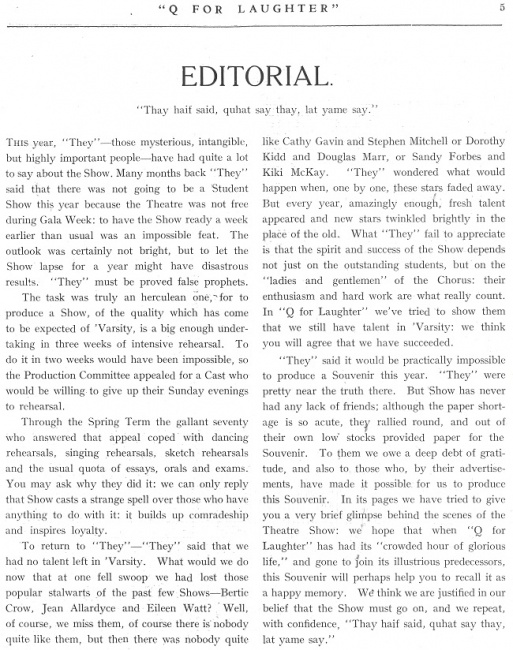
Following on from our article on the beginnings of the University's Student Show, we take a look at how Show changed in the 1940s and get the reminiscences of an alumna who was heavily involved at the time...
The start of the 1940s heralded changes for the Student Show, largely due to the onset of the Second World War. Looking back, it is remarkable that Show continued at all in the midst of the bombing and austerity; yet continue it did, bringing a little light and laughter into people's lives and encouraging the people of Aberdeen to 'Hold That Smile' during the 20th Century's darkest days. Following the previous few years of single-story musical comedies, Show returned to the format of a revue, an assortment of unconnected sketches and song and dance numbers. The reasons for this were mostly practical; a revue required less in the way of scenery, for one, and during wartime precious resources were not to be wasted on the frivolity of theatre-dressing. Also, a revue did not call for such a balanced cast as for a musical comedy, and with so many men away fighting, the revue format made this aspect much simpler; the loss of long-term show producer Dr Douglas Raitt, who was selected to be a Civil Defence Commissioner in another part of the country, was a particular blow to Show organisers, and with his replacements having previous experience of the revue format, the switch was a natural choice. The format subsequently remained in place for the whole decade, save for 1946’s performance of ‘To Meet The MacGregors’ (more on that later!).

The prevailing revue format certainly allowed for a level of topicality not altogether possible in the musical comedy genre, and the sketch-writers made the most of it, refusing to shy away from the shadow of war that loomed large over the country. Indeed, the Press and Journal’s reviewer of the 1940 show ‘Watch Your Step’ wrote that “the topic note reaches its height in an A.R.P. inspection and a dance by ten Air Raid Wardens. Other characters include Herr Sauerkraut and Fraulein Sourpuss, foreign spies in search of the Ark Royal.” (In reality, the Ark Royal, a British aircraft carrier, was sunk by a U-boat a year later). The War was also manifested prominently through the illustrations on the covers of the by-now-traditional souvenir programme.

While the War may have provided a topic of inspiration creatively, it also limited the show in various ways; sourcing paper for the “souvie” was a challenge, while one show in the early 40s was dressed on just 10 clothing ration coupons, surely something of a miracle when one considers that one pair of women’s shoes alone cost 5 coupons. Indeed, with clothing rationing continuing until March 1949, the Board of Trade’s refusal to supply adequate coupons to dress the 1948 Show ‘Hooray For What’ led to “a rollicking reply” in the form of a sketch in the show that featured Alan Pattillo and Sheila Hepburn garbed in sacking, a striking image from which was featured as the leading picture on the front page of Aberdeen’s main paper beneath the headline ‘Students Show “Hit” – At The Board of Trade’! (In terms of notable Show alumni, it is worth mentioning that Alan Pattillo went on to have a long career behind the scenes in television and film, directing and writing on shows such as 'Thunderbirds' and 'The Avengers', editing sound for Nicholas Roeg’s ‘Performance’ and Alan Parker’s ‘Pink Floyd: The Wall’ and winning an Emmy for film editing on ‘All Quiet On The Wester Front’ as well as working as associate editor on the multiple Oscar-winning film 'Gandhi').

Alan Pattillo and Sheila Hepburn (1948)
In some ways, however, the War meant opportunity, particularly for women, as with many of the men having gone off to fight, women were now able to emerge from their traditional roles making the costumes and directing the dancers to flex their muscles creatively; 1943’s 'Nuts in April' marked the first time a woman had taken the role of producer/director when Pollie Bundy took the helm, and most of the show’s music that year was written by another woman, Addie Davidson, who also established a record by taking the conductor’s baton for one of the songs, and indeed, reprised her role as Musical Director and chief composer for 1947's 'Cakes and Ale'. Sadly, however, Mrs Bundy’s appearance in the director’s chair wasn’t exactly to be the start of a new age - it took until 1980 for another woman to inhabit the show’s most important behind-the-scenes role.

Pollie Bundy (L) and Addie Davidson (R)
The decade’s only musical comedy, 1946's ‘To Meet The MacGregors’, was a pastiche of Sir Walter Scott’s ‘Rob Roy’ written by the University rector at the time, a certain Mr Eric Linklater, who had, of course, penned the first three Student Shows while a student at Aberdeen in the early 1920s. Despite some impressive period costumes, the overall success of this sole musical comedy in amongst a series of successful revues is questionable; in his introduction for the script’s print edition a few years later, Linklater lamented the cast’s lack of “anyone who could sing with more than a drawing-room talent” and in one review of the first night, a local journalist wrote that “the programme had little in common with the intentions of its author”, although to be fair he did also say that it provided "happy enough entertainment". Also, his assessment may have been clouded slightly by the fact that the performance was marred so badly by the opening ‘student night’ tradition of pelting the cast with pennies, flour bags and stink bombs from high up in the ‘Gods’ that the University Principal denounced the practice in the press and the Show’s continuation at His Majesty’s Theatre was, briefly, in question.

To Meet The MacGregors (1946)
We are fortunate enough to have been contacted recently by Elizabeth Bradley (née Aitken) who took part in several of the war-time shows as an undergraduate and also ‘To Meet The MacGregors’ as a postgraduate, and she was kind enough to share her recollections:
“Student Shows hold a very special place in my heart, maybe because I had a longer association with them than the usual years of doing one's degree. My father was involved in Show from the time of the amazing 'Town and Gown' (1933), first as stage manager under Bill Norrie and then as stage director until the last wartime Show in 1945, fifteen Shows in all. He earned his title of 'Father of the Show' and I suppose even more so during the years when he had a daughter in the cast. As a senior schoolgirl I was taken by him to many rehearsals and became really involved, regarding with awe those who were in those days the "stars" of the Show.

'Father of the Show' Robert Aitken and his daughter Elizabeth
The Shows in which I took part were during wartime, except for 'To Meet The MacGregors' (1946) as I was a postgrad student that year. My Shows were 'Nuts in April', 'Marischal Moments' and 'Q for Laughter'. Being held during wartime, they faced special difficulties, although I can't remember any air raids interrupting rehearsals or Show week, even the many "hit and runs" that we had. There was never any doubt in my mind that I would take part in Show. I did have parts in various sketches, but, having been a pupil of the Hendry School of Dance since I was four my main contribution was in the dancing line, both in the chorus, which was hard work but such fun, and in some solo roles. I made sure my cutting book received the newspaper cutting that named me once as "principal dancer" - fame at last!
With clothes rationing in full force, the Wardrobe ladies had a very difficult job and what they produced was absolutely fantastic. Being in Show was like being in one big family and during those few weeks such comradeship was built up.

'Blue Roses' from 1943's 'Nuts in April'. Betty Aitken is third from the right
'Q for Laughter' was an amazing Show and that it was ever staged was a miracle. For some reason His Majesty's Theatre was not available during Gala Week, hence the Show had to be staged a week earlier than usual. To produce a Show of quality in three weeks is difficult enough, but in two -- ! We gave up Sunday evenings and coped with rehearsals and the usual quota of essays, orals and exams. As editor of the Souvenir I wrote about it, so I remember it well. I also remember how difficult it was to get any paper for printing the Souvenir, but our paper company friends rallied round and provided paper from their own low stocks.
These days I can still remember the faces of the "stars" of those Shows - Bertie Crow, Jean Allardyce, Eileen Watt, John Kilgour and earlier ones - Cathy Gavin, Dorothy Kidd, Douglas Marr, Sandy Forbes and Kiki Mackay.

Bertie Crow and Jean Allardyce (1944)
A Student Show is really something special and, I think, an important part of the University’s history and heritage.”
You can read Elizabeth's original Editorial from the 1945 Show here:



